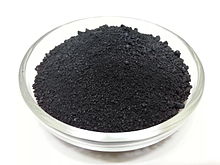Remove ads
Ruthenium(III) chloride is the chemical compound with the formula RuCl3. "Ruthenium(III) chloride" more commonly refers to the hydrate RuCl3·xH2O. Both the anhydrous and hydrated species are dark brown or black solids. The hydrate, with a varying proportion of water of crystallization, often approximating to a trihydrate, is a commonly used starting material in ruthenium chemistry.
 | |
 | |
| Identifiers | |
|---|---|
| |
3D model (JSmol) |
|
| ChemSpider | |
| ECHA InfoCard | 100.030.139 |
PubChem CID |
|
| RTECS number |
|
| UNII | |
CompTox Dashboard (EPA) |
|
| |
| |
| Properties | |
| RuCl3·xH2O | |
| Molar mass | 207.43 g/mol |
| Melting point | >500°C (decomposes) |
| Soluble, Anhydrous is insoluble | |
| +1998.0·10−6 cm3/mol | |
| Structure | |
| trigonal (RuCl3), hP8 | |
| P3c1, No. 158 | |
| octahedral | |
| Hazards | |
| Flash point | Nonflammable |
| Related compounds | |
Other anions |
Ruthenium(III) bromide |
Other cations |
Rhodium(III) chloride Iron(III) chloride |
Related compounds |
Ruthenium tetroxide |
Except where otherwise noted, data are given for materials in their standard state (at 25 °C [77 °F], 100 kPa).
| |
Anhydrous ruthenium(III) chloride is usually prepared by heating powdered ruthenium metal with chlorine. In the original synthesis, the chlorination was conducted in the presence of carbon monoxide, the product being carried by the gas stream and crystallising upon cooling.[1][2] Two polymorphs of RuCl3 are known. The black α-form adopts the CrCl3-type structure with long Ru-Ru contacts of 346 pm. This polymorph has honeycomb layers of Ru3+ which are surrounded with an octahedral cage of Cl− anions. The ruthenium cations are magnetic residing in a low-spin J~1/2 ground state with net angular momentum L=1.[3][4] Layers of α-RuCl3 are stacked on top of each other with weak Van der Waals forces. These can be cleaved to form mono-layers using scotch tape.[5]
The dark brown metastable β-form crystallizes in a hexagonal cell; this form consists of infinite chains of face-sharing octahedra with Ru-Ru contacts of 283 pm, similar to the structure of zirconium trichloride. The β-form is irreversibly converted to the α-form at 450–600 °C. The β-form is diamagnetic, whereas α-RuCl3 is paramagnetic at room temperature.[6]
RuCl3 vapour decomposes into the elements at high temperatures ; the enthalpy change at 750 °C (1020 K), ΔdissH1020 has been estimated as +240 kJ/mol.
Remove ads
α-RuCl3 was proposed as a candidate for a Kitaev quantum spin liquid state[7] when neutron scattering revealed an unusual magnetic spectrum,[8][9][10] and thermal transport revealed chiral Majorana Fermions when subject to a magnetic field.[11]
As the most commonly available ruthenium compound, RuCl3·xH2O is the precursor to many hundreds of chemical compounds. The noteworthy property of ruthenium complexes, chlorides and otherwise, is the existence of more than one oxidation state, several of which are kinetically inert. All second and third-row transition metals form exclusively low spin complexes, whereas ruthenium is special in the stability of adjacent oxidation states, especially Ru(II), Ru(III) (as in the parent RuCl3·xH2O) and Ru(IV).
Illustrative complexes derived from "ruthenium trichloride"
- RuCl2(PPh3)3, a chocolate-colored, benzene-soluble species, which in turn is also a versatile starting material. It arises approximately as follows:[12]
- 2 RuCl3·xH2O + 7 PPh3 → 2 RuCl2(PPh3)3 + OPPh3 + 5 H2O + 2 HCl
- Diruthenium tetraacetate chloride, a mixed valence polymer, is obtained by reduction of ruthenium trichloride in acetic acid.
- [RuCl2(C6H6)]2 arises from 1,3-cyclohexadiene or 1,4-cyclohexadiene as follows:[13][14]
- 2 RuCl3·xH2O + 2 C6H8 → [RuCl2(C6H6)]2 + 6 H2O + 2 HCl + H2
- Ru(bipy)3Cl2, an intensely luminescent salt with a long-lived excited state, arising as follows:[15]
- 2 RuCl3·xH2O + 6 bipy + CH3CH2OH → 2 [Ru(bipy)3]Cl2 + 6 H2O + CH3CHO + 2 HCl
This reaction proceeds via the intermediate cis-Ru(bipy)2Cl2.[15]
- 2 RuCl3·xH2O + 2 C5Me5H → [RuCl2(C5Me5)]2 + 6 H2O + 2 HCl
[RuCl2(C5Me5)]2 can be further reduced to [RuCl(C5Me5)]4.
- RuCl3·xH2O + 3 C5H8O2 → Ru(C5H7O2)3 + 3 H2O + 3 HCl
- RuO4, is produced by oxidation.
Some of these compounds were utilized in the research related to two Nobel Prizes. Ryōji Noyori was awarded the Nobel Prize in Chemistry in 2001 for the development of practical asymmetric hydrogenation catalysts based on ruthenium. Robert H. Grubbs was awarded the Nobel Prize in Chemistry in 2005 for the development of practical alkene metathesis catalysts based on ruthenium alkylidene derivatives.
Carbon monoxide derivatives
RuCl3(H2O)x reacts with carbon monoxide under mild conditions.[18] In contrast, iron chlorides do not react with CO. CO reduces the red-brown trichloride to yellowish Ru(II) species. Specifically, exposure of an ethanol solution of RuCl3(H2O)x to 1 atm of CO gives, depending on the specific conditions, [Ru2Cl4(CO)4], [Ru2Cl4(CO)4]2−, and [RuCl3(CO)3]−. Addition of ligands (L) to such solutions gives Ru-Cl-CO-L compounds (L = PR3). Reduction of these carbonylated solutions with Zn affords the orange triangular cluster Ru3(CO)12.
- 3 RuCl3·xH2O + 4.5 Zn + 12 CO (high pressure) → Ru3(CO)12 + 3x H2O + 4.5 ZnCl2
Remove ads
- Becker, Ramona; Hartwig, Helga; Köppe, Herbert; Vanecek, Hans; Velić, Paul; Warncke, Rudolf; Zelle, Anna (1978). Warncke, Rudolf (ed.). Gmelin Handbuch der Anorganischen Chemie. doi:10.1007/978-3-662-06224-1. ISBN 978-3-662-06226-5.
Remove ads
Wikiwand in your browser!
Seamless Wikipedia browsing. On steroids.
Every time you click a link to Wikipedia, Wiktionary or Wikiquote in your browser's search results, it will show the modern Wikiwand interface.
Wikiwand extension is a five stars, simple, with minimum permission required to keep your browsing private, safe and transparent.
Remove ads